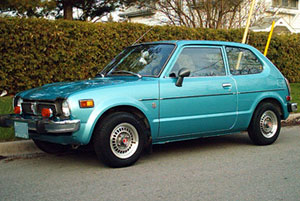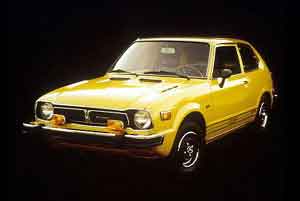
Induction Options
Choices For a First Generation Honda Civic 1 there are several options.
- Randy
- Administrator

- Posts: 1449
- Joined: April 7th, 2005, 9:06 pm

- Province/State: Ontario
- Hometown: Ajax
- Model: 1978 Hatchback
Induction Options
DGV / DGAS.... Most of the time, this is a bad choice for all but the most mundane of street cars.
Negatives -The float bowl of a DGV or other Weber's of the same style are very noted for starving the engine for fuel under hard cornering in a FWD set up like on the Gen1. The common aftermarket adapters are very poor and can only be marginally improved. EVERYONE THAT HAS TRIED AUTOX WITH A DGV HAS PULLED IT OFF OR SWITCHED ITS POSITION!
Positives - Very common carburetor, parts are easy to source and in-expensive.
Fixes - A custom adapter has been used to reorient the carburetor to a position 90 degrees from stock this fixes both the flow problems and helps the fuel starving problem quite a bit.
DATR / DAT / DMTR 34mm
This carburetor is very good for both performance and street use
Negatives - Custom adapter is needed for gen 1, Very slight fuel starvation problem but you will not find this with street tires.
Positives - WAY better carburetor - designed for a FWD engine setup -orientation of carburetor is same as OEM.
Fixes - You can relocate the enrichment circuit to the bottom of the float bowl with a section of brass tube bent like a \"J\" Or for race use you can jet rich.
DCNF 36-42
Negatives - Custom adapter is needed for gen 1, requires turning mount 90 degrees to the factory carburetor orientation, making it fit correctly is a bit more difficult than any of the above.
Positives - for a gen 1 this is the biggest most tunable down draft Weber for performance use, HP equal or better than a single side draft can be achieved with a proper combo of carburetor and manifold mods.
Fixed Venturi Sidedrafts DCOE- DHLA- DHLB- PHH
Negatives - Hard to find manifolds, and linkages, Multiple carburetors are more expensive. May loose response over designs below, but a good choice anyway
Positives - If you have the engine these carburetors can make a big difference if properly tuned to the application, will be a few pounds lighter than other four venturi setup because of the lack of moving parts.
RS Carburetors
Negatives - Lean out much like a DGV under cornering but not as bad. Some parts are obsolete! Lots of moving parts so the carburetor are heavy. Complete setups are hard to find. You must have the air cleaner base as it has the fuel supply!
Positives - If you familiar with an SU carburetor and its low end response then you will be pleased with the Keihin Vacuum Slide design. Very responsive for street use if tuned properly! D.Vizard has a few books describing the potential advantages of this design.
Mugen MS1
Negatives - Similar to RS setup with a few changes, Parts are obsolete, Complete setups are hard to find. Heavy x 2 compared to the RS as it has four carburetors.
Positives - four vacuum slide Carburetors = Top end power and low rpm response. No lean out in corners, maybe because of four float bowls instead of two?
Mugen MS2
Negatives - Hard to find complete setups, Mechanical slide venturies loose some low end response but not as bad a fixed venturi carburetor, Banned in many SCCA Classes as its too big an advantage over fixed venturi carburetors.
Positives - Carburetor Parts can be bought as they CR's are being made today. Airflow king without loosing too much low end because of the mechanical slides.
Fuel injection / turbos ... Try it.
Originally Published By Don
Negatives -The float bowl of a DGV or other Weber's of the same style are very noted for starving the engine for fuel under hard cornering in a FWD set up like on the Gen1. The common aftermarket adapters are very poor and can only be marginally improved. EVERYONE THAT HAS TRIED AUTOX WITH A DGV HAS PULLED IT OFF OR SWITCHED ITS POSITION!
Positives - Very common carburetor, parts are easy to source and in-expensive.
Fixes - A custom adapter has been used to reorient the carburetor to a position 90 degrees from stock this fixes both the flow problems and helps the fuel starving problem quite a bit.
DATR / DAT / DMTR 34mm
This carburetor is very good for both performance and street use
Negatives - Custom adapter is needed for gen 1, Very slight fuel starvation problem but you will not find this with street tires.
Positives - WAY better carburetor - designed for a FWD engine setup -orientation of carburetor is same as OEM.
Fixes - You can relocate the enrichment circuit to the bottom of the float bowl with a section of brass tube bent like a \"J\" Or for race use you can jet rich.
DCNF 36-42
Negatives - Custom adapter is needed for gen 1, requires turning mount 90 degrees to the factory carburetor orientation, making it fit correctly is a bit more difficult than any of the above.
Positives - for a gen 1 this is the biggest most tunable down draft Weber for performance use, HP equal or better than a single side draft can be achieved with a proper combo of carburetor and manifold mods.
Fixed Venturi Sidedrafts DCOE- DHLA- DHLB- PHH
Negatives - Hard to find manifolds, and linkages, Multiple carburetors are more expensive. May loose response over designs below, but a good choice anyway
Positives - If you have the engine these carburetors can make a big difference if properly tuned to the application, will be a few pounds lighter than other four venturi setup because of the lack of moving parts.
RS Carburetors
Negatives - Lean out much like a DGV under cornering but not as bad. Some parts are obsolete! Lots of moving parts so the carburetor are heavy. Complete setups are hard to find. You must have the air cleaner base as it has the fuel supply!
Positives - If you familiar with an SU carburetor and its low end response then you will be pleased with the Keihin Vacuum Slide design. Very responsive for street use if tuned properly! D.Vizard has a few books describing the potential advantages of this design.
Mugen MS1
Negatives - Similar to RS setup with a few changes, Parts are obsolete, Complete setups are hard to find. Heavy x 2 compared to the RS as it has four carburetors.
Positives - four vacuum slide Carburetors = Top end power and low rpm response. No lean out in corners, maybe because of four float bowls instead of two?
Mugen MS2
Negatives - Hard to find complete setups, Mechanical slide venturies loose some low end response but not as bad a fixed venturi carburetor, Banned in many SCCA Classes as its too big an advantage over fixed venturi carburetors.
Positives - Carburetor Parts can be bought as they CR's are being made today. Airflow king without loosing too much low end because of the mechanical slides.
Fuel injection / turbos ... Try it.
Originally Published By Don






